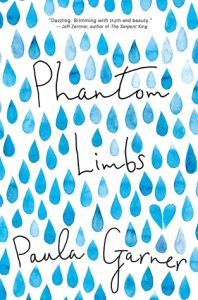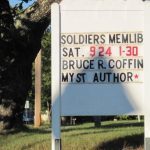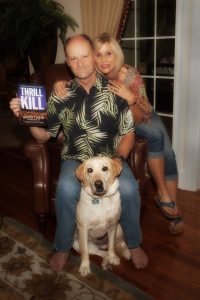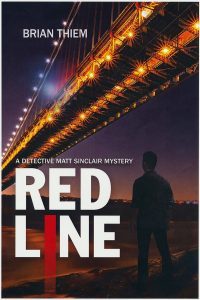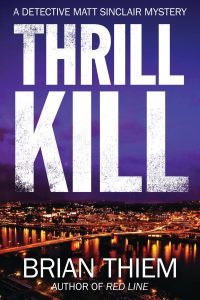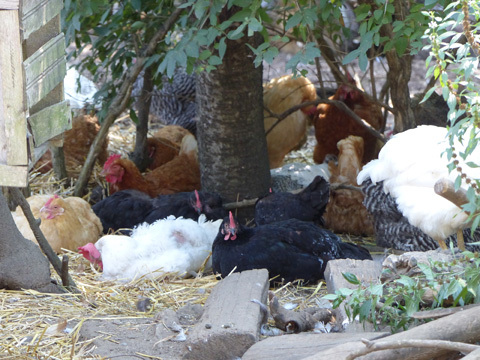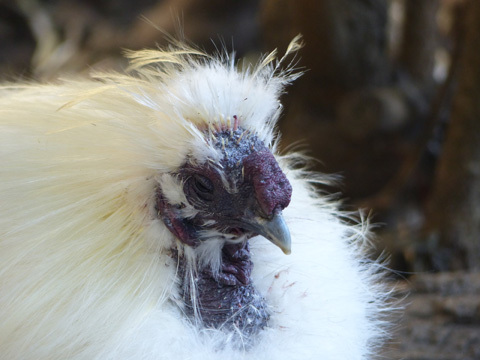Kathy Lynn Emerson's Blog, page 63
September 30, 2016
Red at Night, Mainers delight
Kate Flora here, red with mortification at forgetting to blog today. It’s a long story. Anyway, in case you still tune in today, here are a few of the gorgeous sunsets we’ve been enjoying lately.




September 29, 2016
Going with strength
John Clark with an admission or two. Unlike sister Kate, I didn’t grow up to be a writer. True, I had a vivid and dangerous imagination, but wanted to be a baseball player and later just wanted to survive. Writing came in my 40s after Mom and Kate were really into it and having success. My first forays were as a newspaper columnist, then a contributor to a book on libraries in mental health settings and finally a YA fantasy novel. In hindsight, it could have been a better book, but it introduced me to a more structured imagination and was followed by four more in the same imaginary universe. All four slumber on my computer years later. They’ve been joined by an adult sci-fi novel and three more or less completed YA urban fantasies/romance/mysteries.
What happened to leave them in a not-yet-completed pile? If I could answer that question I would and do so gladly, but every time I ponder the question, it’s like nailing jello to the wall in a dark basement while wearing mittens. Mom’s death knocked the stuffing out of me, 9/11 had a smaller effect, but if there’s a blockbuster reason, it continues to elude me. Make no mistake, I’m not feeling sorry for myself, just trying to be honest.
Along the way, I discovered the seductive allure of writing short stories. Heck, on a good day, I can knock one out, let it simmer for a few days and polish it nicely. Contrast that to the time and effort involved in writing a book and it’s pretty clear why that kind of writing has a siren song.
I’m also pretty comfortable in my retired life after the first year and when I look at the effort and time my fellow MCW members devote to getting their work in front of readers, it makes me wonder if I want to change that much in my life. There’s also the ADHD aspect of sitting at the computer. I get distracted way too easily. Need another cup of coffee, gotta see if any new email has arrived, who has posted on Facebook, has the mailman come yet, should I pick more raspberries. Looked at logically, this isn’t a particularly sane behavior pattern, but it sits on my shoulder like a demonic monkey all too often.
Perhaps the biggest aspect of my writing life is that more and more, I enjoy reading and reviewing books. Reading is so satisfying and sharing a particularly good book with others makes the experience even more so. I’ve been reviewing for School Library Journal for a few years now, covering educational DVDs and audio books. It’s safe to say I’m their resident expert on addiction and mental health videos. You have no idea how good some of them are and how powerful the message recovering teens can convey when describing their odyssey to hell and back. I also review for Buried Under Books (https://cncbooksblog.wordpress.com/) as well as The CMLD Kids/Teens Review site. (https://cmldbookreviews.com/). Since I don’t finish boring or uninteresting books, I seldom post a negative review. Reviews are satisfying in several ways. First, they make an author feel like their work matters, they give potential readers a peek inside and they can direct readers, particularly teens, to books that may help them make sense of their lives.
Nothing in life is cast in stone. I might wake up tomorrow and be so inspired by a new story idea that I do nothing but write until Veteran’s Day, but for today, what you’ve read is my reality and was important to share. I’ll end with my latest book review below.
Phantom Limbs by Paula Garner, Candlewick (September 27, 2016). ISBN: 9780763682057.
Imagine a story where every character is one of the walking wounded, but because they are, nobody is able to understand and work through what they all share.
Dara lost an arm to a shark while swimming in Hawaii. It ended her hopes of being an Olympic swimmer and broke any positive connection to her father who was her coach. Then there’s the issue surrounding her late mother, not to mention her gender identity issue. She’s compensated by trying to train Otis to be her surrogate Olympian and it has helped him cope (barely) with his twin losses, the tragic death of his little brother and the sudden move, not long after, by his best friend Meg, who he confided in and loved a lot. He’s gone three years with no contact, but has never gone a day without wondering and imagining. Otis’ parents are stuck in the storm of grief generated when their younger son Mason died. They were best friends with Meg’s parents who lived next door, but something unspoken now lies between the former best friends.
When Meg’s parents separate, her dad takes a transfer back to the branch of his company near by and Meg breaks silence to let Otis know she is coming for a three week visit and needs to talk. What follows reminded me of a satellite in a descending orbit. Every time it passes over Truthtown, you learn a little more about everyone’s secret demons and tense up, expecting a fiery crash. Instead, Paula skillfully navigates the story to an incredibly satisfying landing that left me smiling and hopeful. All the characters are likable, but I couldn’t help but root for Dara, Meg and Otis, three teens in pain through no fault of their own. Granted there are F-bombs in the story, but they shouldn’t deter any library from adding this to their YA collection.
September 27, 2016
The Dog in the Room
Dorothy Cannell: I currently have on my refrigerator a photo of an eleven-day-old

Not Dorothy’s puppy, but another dog eager to become someone’s pet
Cavalier King Charles puppy, eyes still sealed shut and a bald nose. His name is Watson. I know that because I chose it after asking my dog loving daughter-in-law, Cindy, to search on line for a reputable breeder. Mission accomplished when she found one in Connecticut with a female expecting a litter. Last Sunday afternoon Cindy brought round the photo along with another of the mother as a puppy, delightedly she informed me Watson should be ready to bring home in eight-weeks-time again. After positioning the photo and stepping back to yearn over it, I was filled with the belief that life had acquired a wonderful new dimension. The dampening question was: would this view be fully shared by rest of the household?
I broke the news of the soon-to-be bundle of joy to Teddy our ten-year-old Cavalier and Simeon our two-year-old Siamese cat, and neither threatened to pack their bags and leave in protest. Teddy enjoys being with his own kind, and Simeon thinks he’s a dog – coming when called, sitting up to beg for treats, and following my husband Julian and me from room to room in terror of never seeing us again. I had counted on a positive response from the four footed members of the family, but knew not to expect leaps of joy from Julian.
When I broached the subject of a getting puppy several months ago, he was flatly against it. At that time we had a second cat (sadly she died recently of old age) and he said we had enough pets, also he didn’t want to go through the bother of house training, but he did finally threw up his hands and agreed. The fair and sensible thing for me to have done would have been to let him know I’d put Cindy on the search, but I persuaded myself it was best not to ripple the waters until there was something to report. And now here I was feeling defensive, torn between righteousness and guilt.
What does this personal anecdote have to do with writing? It’s an answer to the question: “Do you draw upon the traits of people you know when creating characters?” There are moments when I listen to people talking and observe their behavior, and wonder: do you ever think how unappealingly you would come across in a book?” In the situation above would that person be the husband crushing his wife’s spirit, draining all the joy out of life? Or would she be the unsympathetic one – sneaky, manipulative, intent on having her own way, never considering the wants or needs of others?
The husband doesn’t flesh out, but there is meat on the wife’s bones. Where better to mine for unlikeable traits than within myself? I have a place for her in my next book. I shall call her Mildred because she has emotionally mildewed over the years. Of course I’ll change her physically, so I won’t risk having to sue myself.
As for Julian’s reaction to the Watson revelation? It was cheerful. He said he looked remarkably intelligent for eleven-days-old and it should be elementary to housetrain him. That’s the thing about characters in books – they should always be able to surprise us. I’ll have to find out how Mildred can do that for me… she must have some nice qualities. Maybe, as I said to Simeon, she likes cats. Siamese ones.
 That’s it for now, I have to exclaim enthusiastically over the miniature pig someone with a name beginning with ‘J’ insisted on getting, saying he felt entitled to a pet of his own. Some of us should really listen to ourselves once in a while.
That’s it for now, I have to exclaim enthusiastically over the miniature pig someone with a name beginning with ‘J’ insisted on getting, saying he felt entitled to a pet of his own. Some of us should really listen to ourselves once in a while.
Best, Dorothy.
September 26, 2016
What Am I Up To?
Hi. Barb here and thank you so much for asking.
I have an embarrassment of riches in the last quarter of 2016–two books launching!
 Eggnog Murder is coming October 25, 2015 in hardcover, ebook, and audio. (Large print is coming later). The book is a collection of holiday novellas by Leslie Meier, Lee Hollis, and me, based on each of our Maine-based cozy mystery series. In a starred review, Publishers Weekly said, “This anthology boasts three terrific tales of yuletide murder in coastal Maine…It’s not just the nog: sparkly writing, and emotional depth link this trio of holiday cozies.” About my contribution to the collection, “Nogged Off,” PW said, “…a creepily convincing tale of tinsel-decked, cookie-scented psychopathology.” (Which I kind of love as a description.)
Eggnog Murder is coming October 25, 2015 in hardcover, ebook, and audio. (Large print is coming later). The book is a collection of holiday novellas by Leslie Meier, Lee Hollis, and me, based on each of our Maine-based cozy mystery series. In a starred review, Publishers Weekly said, “This anthology boasts three terrific tales of yuletide murder in coastal Maine…It’s not just the nog: sparkly writing, and emotional depth link this trio of holiday cozies.” About my contribution to the collection, “Nogged Off,” PW said, “…a creepily convincing tale of tinsel-decked, cookie-scented psychopathology.” (Which I kind of love as a description.)
I call this book Maine Clambake Mystery #4.5 because my story, “Nogged Off” picks up right after Fogged Inn ends. When Julia travels to New York City to empty her apartment, she meets her subtenant and things spiral out of control. I loved incorporating the holiday traditions from my Maine coastal town, as well as some from my family.
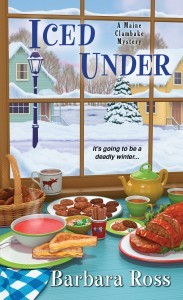 Iced Under releases on December 27, 2016. Here’s the description:
Iced Under releases on December 27, 2016. Here’s the description:
The snow is deep in Maine’s Busman’s Harbor and the mighty rivers are covered in ice. Snowden Family Clambake Company proprietor Julia Snowden and her mother, Jacqueline, are hunkered down for the winter when a mysterious package arrives—heating up February with an unexpected case of murder . . .
I loved writing this story of how Julia Snowden’s mother’s family made the money that enabled them to build their mansion on private Morrow Island, and how they lost it. I hope my readers love it, too.
To support these books, I have a busy fall lined up. Here’s a list of upcoming appearances.
Friday, September 30, through Saturday, October 1, 2016
I’ll appear with a host of other Maine mystery authors at Murder by the Book
Jesup Memorial Library
34 Mount Desert Street
Bar Harbor, ME 04609
Saturday, October 8, 2016, from 9:00 am to 6:00 pm
I’ll appear with a host of other mystery writers at Mysterium: The Mystery Novel Conference. (Registration required.) I’ll teach a course in Revising Your Mystery and moderate the cozy mystery panel.
Wesleyan University
Usdan University Center
45 Wyllis Ave
Middletown CT, 06459
October 26, 2016 at 7:00 pm
I’ll participate with Maine authors Kate Flora and Lea Wait in “Death and Desserts.”
South Berwick Public Library
27 Young Street
South Berwick, Maine 03908
Phone: 207-384-3308
Saturday, November 5, 2016 at 1:00 pm
I’ll speak and sign with author Lea Wait at
Sherman’s Maine Coast Bookshop and Cafe
158 Main Street
Damariscotta, ME 04543
Phone: 888-563-3207
Sunday, November 6, 2016, 3:00 to 5:00 pm
I’ll be reading and signing with most of the Maine Crime Writers at
Bull Feeney’s
375 Fore St
Portland, ME 04101
Friday, November 11, through Sunday, November 13, 2016
I’ll appear at the New England Crime Bake (Registration Required). I’ll be moderating a panel on Creating Your Town.
Hilton Boston/Dedham
1-781-329-7900
25 Allied Drive
Dedham, MA 02026
I’m looking forward to my busy fall and would love to see any Maine Crime Writers readers at any of these events!
Save
Save
Save
Save
Save
Save
Save
September 25, 2016
Where Did The Summer Go?
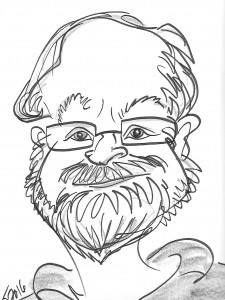 As I sit here on the evening of the first day of autumn, watching this year’s potato crop being harvested, I can’t help but ask, “Where did the summer go?” Up here in The County we joke that “I overslept one day in May and missed the entire summer!” Still every year we watch the leaves turn color, begin cleaning our shotguns and rifles, and face the fact that in two months (a mere eight weeks) we could be dealing with our first snowfall of the winter. I realize that since June I have done barely a single paragraph of writing and do a mental inventory of what I accomplished since June.
As I sit here on the evening of the first day of autumn, watching this year’s potato crop being harvested, I can’t help but ask, “Where did the summer go?” Up here in The County we joke that “I overslept one day in May and missed the entire summer!” Still every year we watch the leaves turn color, begin cleaning our shotguns and rifles, and face the fact that in two months (a mere eight weeks) we could be dealing with our first snowfall of the winter. I realize that since June I have done barely a single paragraph of writing and do a mental inventory of what I accomplished since June.
There were a number of appearances, eight at Thursdays On Sweden in Caribou, one in Freeport, 4th of July in Belgrade lakes with several other Crime Writers. There were three appearances at Aroostook County libraries and The Potato Blossom Festival in Fort Fairfield–and then there was the thing that consumed the greatest block of my time. On June 6 my nephew passed away in Florida. Usually a funeral would only take a few days, but not this one (sometimes I think that all it would take to complicate a roll call in a one-man submarine is for me to be involved).
Richard, or Rick as we called him, was fighting cancer and in strong denial of his inevitable demise. He was a life-long bachelor with no children and more importantly no will. His mother, my 88 year-old sister-in-law, had no idea how she was to handle things. You’ve heard the expression “Once a Marine; always a Marine”? I of course saw her dilemma and rode to her rescue. What I assumed would take a week, two at the most, is still an open issue. Dealing interstate with this stuff will drive one to the nearest bottle of Makers Mark! It is now September 22 and we have finally made enough progress that we can see the end of the process…
Guess what? I just found out where my summer went! Now that fall is here I hope to have some time for myself–once I finish winterizing the house that is…
September 23, 2016
Weekend Update: September 24-25, 2016
 Next week at Maine Crime Writers there will be posts by Vaughn Hardacker (Monday), Barb Ross (Tuesday), Dorothy Cannell (Wednesday), John Clark (Thursday), and Kate Flora (Friday).
Next week at Maine Crime Writers there will be posts by Vaughn Hardacker (Monday), Barb Ross (Tuesday), Dorothy Cannell (Wednesday), John Clark (Thursday), and Kate Flora (Friday).
In the news department, here’s what’s happening with some of us who blog regularly at Maine Crime Writers:
Saturday, September 24, 1:30 – 3:00, Bruce Robert Coffin will be at Soldier’s Memorial Library, 85 Main Street, Hiram, ME.
Many of us will be at the Jesup Library in Bar Harbor next Friday evening and Saturday for Murder by the Book: http://jesuplibrary.org/murder-by-the-book-2/
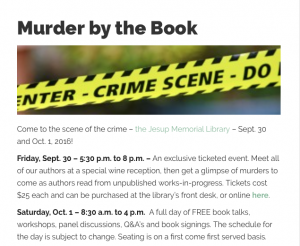
The August winner of a bag of books is Sheryl Booth of Portland . . . Tennessee.
An invitation to readers of this blog: Do you have news relating to Maine, Crime, or Writing? We’d love to hear from you. Just comment below to share.
And a reminder: If your library, school, or organization is looking for a speaker, we are often available to talk about the writing process, research, where we get our ideas, and other mysteries of the business. Contact Kate Flora
Interview with Author Brian Thiem
Bonjour, fellow readers and scribes. Bruce Robert Coffin here with a real treat. This month I’m pleased to introduce friend, author, and former crime fighter Brian Thiem.
Brian, author of the acclaimed series debut Red Line, spent 25 years with the Oakland Police Department, working Homicide as a detective sergeant and later as the commander of the Homicide Section. He also spent 28 years of combined active and reserve duty in the Army, retiring as a Lieutenant Colonel. His final assignment was a tour in Iraq as the Deputy Commander of the Criminal Investigation Group (CID) for the Middle East. His second novel, Thrill Kill, was released last month. So, without further ado, here’s Brian Thiem!
Tell us a bit about your latest novel, Thrill Kill.
Cops in Oakland seldom meet people whose lives are going well. That’s certainly the case when homicide sergeant Matt Sinclair recognizes the dead woman hanging from a tree as a teenage runaway named Dawn he arrested ten years before. And as Sinclair and his partner, Cathy Braddock, soon learn, many of Dawn’s clients, not to mention the local and federal officials who protect them, will go to any length to keep the police from digging into her past. Then the killer goes public, and Sinclair and Braddock must race to uncover the secrets Dawn was killed to protect before the killer unleashes a major attack on a scale the city has never seen before.
You’ve written two books in this series, Red Line and now Thrill Kill. How did this series come to be? Was it envisioned from the start as a series or were you thinking one off? Please tell us a bit about the origin.
I always liked reading series. Two of my favorites were Michael Connelly’s Harry Bosch novels and John Sandford’s Lucas Davenport books, so when I began writing my first novel in a writing workshop years ago, the idea of a series was always in the back of my mind. However, I never dreamed a publisher would be interested in one of my books, much less a series. I felt I had a great character in Matt Sinclair, and when I finished the novel that would eventually become Red Line, I knew Sinclair was strong enough to carry a series. I was thrilled when my agent, Paula Munier, and my publisher, Crooked Lane Books, agreed.
What do you feel are the main theme(s) of each book?
There’s an overarching theme of justice will always prevail in every book because that’s what Matt Sinclair is all about. He is a sort of modern-day knight, a protector of the weak, which in a homicide case is often the deceased victim. He must speak for the dead and achieve justice on their behalf. But he has an even higher purpose—that of bringing the killer to justice because when people can murder with impunity, society crumbles. An additional theme in Red Line centers on regrets from our past. Partly because of Sinclair’s alcoholism, he failed to solve a past murder, which may have been a reason for the murders occurring in this story. Questions that arise include: can one make amends for past misdeeds, are we responsible for every consequence of our past actions, and can one forgive himself for things he’d done. These same themes come into play in Thrill Kill, in addition to Sinclair’s need to save the people he’s sworn to protect and serve in a city where murder is a fact of life.
Why do you feel this is important, and what would you want a reader to take away from reading these books?
I’m careful not to force feed anything to readers. However, at the same time, I don’t apologize for writing books where cops are the good guys. I hope readers get a glimpse at what it’s like to be a cop in a violent urban environment, the toll it takes on those who carry a badge and gun for a living, how they struggle to maintain their humanity amidst the violence and despair, and how they somehow step up and fight the heroic battles when called upon to do so.
I understand you’re working on the third book in the series. What can you tell us about it?
Detective Matt Sinclair will stop at nothing to find the killers of his former partner in Shallow Grave. When the coroner’s office uncovers a body buried in a shallow grave, homicide sergeant Matt Sinclair expected to find the body of one of the city’s drug dealers, probably eliminated by a rival. Instead, the victim was Phil Roberts, his former partner and the present commander of the department’s intelligence unit. Police brass want a quick clearance and to pin the murder on a dead member of an outlaw motorcycle gang, but Sinclair and his partner, Cathy Braddock, aren’t satisfied. As Sinclair uncovers the details of Roberts’s past, secrets from his work and personal life come to life—secrets that some people will go to any length to keep buried. But Sinclair won’t stop until he finds the truth, even if it means sacrificing his career and destroying his former partner’s reputation.
What makes a good book or engaging story?
Jeez, I wish I knew the secret formula. I know there must be a main character that readers care about. That is doubly important for a series. Readers come back and read future books in the series to find out more about Matt Sinclair and his friends, see how their lives are going, and how they will solve the next murder they’re assigned. Unlike the real world where I didn’t solve every murder case I was assigned, I prefer my books have a more “happy ending.” I think readers of crime fiction like a world that’s set right again in the end, so Sinclair solves the murder in every book and brings the killer(s) to justice, either in handcuffs or a body bag. And in a future book, he might even get the girl in the end.
You’ve already had two very distinguished careers. You’ve served overseas in the military and at home on a police force. Do you think these experiences have added depth to your writing? How?
Gosh, yes! There are very few of us, Bruce Robert Coffin is one of the others, who can write authentic cop thrillers because we lived the life. If I write about my character searching a dark house for an armed man, I know what it feels like. I know what it’s like to work a case for days on end, living on a few hours of sleep and caffein, with the brass constantly on me for a quick clearance. I know Glocks don’t have safeties and revolvers don’t have clips, and I know what it’s like to having your life depend on how well you can use them. I know how cops think and act, how cars behave when taking a corner too fast in a pursuit, and what it feels like to fight for your life and to be afraid to die. I try to inject that in my writing.
Are there writers with similar themes to yours? Who are your influences (can be writers, or even artists, musicians, or others) and what is it about their work that attracts you?
I’ve already mentioned Michael Connelly and John Sandford. I like books with heroes who are thrust into difficult situations and rise to the occasion no matter the odds. Two authors in the military/counter terrorism thriller genre who do that extremely well are Brad Thor and Brad Taylor, and two of my favorite Maine crime series authors are Paul Doiron and Kate Flora. All of these main characters have a creed by which they live their lives. It’s why they do what they do.
Is storytelling mostly entertainment, or does it serve other functions? Do you have particular goals other than telling a good story?
We’ve already touched on this when you asked about theme, but I think good fiction must first be entertaining. That’s why most people read fiction. I think writers must be careful if they’re trying to use fiction to educate readers or sway them to their way of thinking. Few readers want to be lectured to or feel as if they’re being indoctrinated in a political philosophy. However, my point of view character is a big city homicide detective. He sees the world as good guys (cops) and bad guys (crooks). He acknowledges there are bad cops, but they’re a small percentage of the profession, so if readers believe all cops are racists who strive to kill innocent people because they saw a few instances of such on the news, they should probably be reading another genre.
Any other goals you’ve set for yourself, professionally or personally?
Play a round of golf with no greater than double bogie on my worst hole. No, seriously, I just try to do the next right thing. I’ve found that when I do that and leave the outcome to someone else, the results are better than I’ve ever achieved when I try to run the show.
Some writers write fast and claim not to rewrite much. Do you do this, or painstakingly revise? When you send the book off to the publisher, are you happy with it, or just tired of it?
Neither. I painstakingly plot my novels, so when I finally sit down to write, I know where they story is going and what the next scene is. It changes and evolves as I write, but if it gets too far from the plot I had outlined, I revise the plot. Once my first draft is finished, the story is pretty solid, so rewrites primarily consist of layering in descriptions, character thoughts and feelings, and word and sentence changes to improve clarity. When I send it to my publisher, I’m tired of it. In the previous month, I’ve read it through three or four times and need a break from it. When my editor sends it back a month or so later with editorial comments, I’m excited about it once again and ready to revise it to make it better.
Do you have good editors, and if so, how do they help you? Do they look for particular things? Do you have different people for different editing levels?
I use my writers groups for parts of the story I know are either incredibly good or a disaster. When my story is finished, my agent reads it and tells me what it needs—normally more action and emotion. My publisher has wonderful editors. They tear it apart and give me suggestions on how to make it better. After I revise it, the publisher has a copyeditor go through it, and I go through the hundreds of edits and comments the copyeditor came up with.
If an aspiring writer came to you for advice, what words of wisdom would you offer?
Read a lot and write a lot. Find people who can offer constructive criticism, either through writers groups, writing workshops, or university writing programs. Make sure you know why you write. If it’s to seek fame and fortune, find another pursuit.
Stories can be told using a variety of different mediums. Can you see your book as a film, audio, etc.? How would that alter the telling?
My books come out in audio as well as print and e-books, and I don’t think there’s any altering necessary. If my books ever make it to Hollywood, I’ll take the advice of a bestselling author—drive to the California border, accept the check and throw your book to the other side. If one of my books is made into a movie or TV series, it’s no longer my book, it is merely a book that inspired a film.
What’s the next step in your writing world? Where do you hope to go from here?
Ask my agent and publisher. I do what they suggest.
Where can folks purchase your novels?
They’re carried in most bookstores, but since I’m not an A-list author, most only stock them for a few months after release. Of course, they’re available online through Amazon, Barnes & Noble, and others.
Web page: www.brianthiem.com
Twitter: @brianthiem
Facebook: brianthiemauthor
September 21, 2016
Field Trip: The VINE Farm Sanctuary
Last month, my boyfriend Ben and I went to visit his cousins, Stephen and Elaine — two well-traveled, kind, and delightfully eccentric septuagenarian vegans in Vermont. Our weekends in Vermont typically include lots of down time playing with the dogs, walking quiet rural roads, and eating a lot of surprisingly tasty vegan food — Ben makes a killer vegan vegetable pot pie, Stephen’s marinades are delicious, and I defy anyone to turn down seconds when Elaine busts out her vegan cheesecake.
During their tenure in the Green Mountain State, Stephen and Elaine have become friends with the people who run VINE Sanctuary, a “haven for animals rescued from the meat, dairy, and egg industries or other abusive circumstances, such as cockfights or pigeon-shoots,” according to the website.
In my new K-9 search and rescue series, out October 25th, the main character runs a wildlife rehab and farm sanctuary on an island off the coast of Maine. That — combined with the fact that farm sanctuaries have always been inspiring, fascinating places to me –meant that I’ve been hoping for an opportunity to visit VINE for a while now. When Elaine asked if we would like a tour during our visit on Labor Day weekend, I jumped at the chance.
Firstly, a few things you should know: VINE stands for ‘Veganism is the Next Evolution.’ The founders, pattrice and Miriam Jones, first founded VINE — then the Eastern Shore Chicken Sanctuary — in rural Maryland in 2000. Over time, the sanctuary expanded to include other animals, and pattrice and Miriam gained national recognition for their work rehabilitating roosters confiscated from cockfighting rings. In 2009, the duo moved the entire operation to what has become a 100-acre spread in Springfield, Vermont, where their work expanded to include rescuing cows from the meat and dairy industries.
When Ben, Stephen, and I arrived that Sunday morning, I followed the fellas through the gate into a mass of lush greenery and surprisingly expansive enclosures housing rescued chickens, roosters, ducks, and even a flock of seagulls. A big yellow house fronts the property, where Miriam and her partner Arum currently reside. That morning, Miriam herself met us in front of the house in T-shirt, torn blue jeans, and muck boots, while half a dozen little dogs — most of them seniors — heralded our arrival with woofs and wags.
Miriam kicked the tour off with the chickens, roosters, and other feathered residents who live in the lower section of the sanctuary. A lot of the chickens in this area have been rescued from the poultry industry, which means many have been genetically altered in some way; over time, they can no longer support their own weight, and develop ailments that simply weren’t seen in the days before scientists and big business joined forces in a quest to give us, the consumer, the ultimate chicken breast.
At VINE, these birds have their choice of several different enclosures, where they can mix with others as they please — chickens are, by their nature, social animals — or retire to a quieter space. A few roosters remain in the mix in this area, though many have been relocated up the hill to more expansive pastures, where they can mix and mingle at will.
Miriam took us up said hill next, where cows, sheep, and emus roam lush fenced pastures. We met Blaine, a pretty Holstein who took a particular liking to Ben, and learned the stories of a multitude of others: Daisy, another Holstein who was on her way to slaughter and was rescued when her piteous cries caught the attention of a passerby familiar with VINE; Melody, who was rescued after she contracted pneumonia as a calf and thus was deemed unsuitable for milking; Poncho and Jasper, two youngsters who came to VINE as calves after they had been chained to a tractor and left to die… The stories went on.
What struck me most about the animals we met wasn’t how outgoing they were, how much like us these creatures could be — something I often hear from others advocating for the humane treatment of animals. What struck me was how much they were…them. Cows and chickens and ducks and peacocks and emus. Some outgoing, some shy, some bullish, some downright goofy. What I loved about VINE was that the space was designed for those animals. It wasn’t laid out for humans to come and be entertained; it was designed as a refuge for animals, many of whom have been profoundly traumatized in their lives, to simply be.
Beyond serving as a sanctuary, those at VINE work hard to create an environmentally sustainable space. Renewable energy, gardening, composting, alternative modes of transportation… These are all daily considerations. Personally, I left that day saddened by the plight of the multitude of animals who won’t be saved by VINE or other farm sanctuaries, but energized by the vast impact just a few people can have. And, yes, I expect many of the things I learned during my tour will make their way into the Jamie Flint series.
If you’d like to learn more about VINE’s mission and the animals they have rescued, I encourage you to check out the website at http://vine.bravebirds.org/.
Jen Blood is author of the bestselling Erin Solomon Mysteries and the Jamie Flint K-9 Search and Rescue Mysteries. To learn more, visit www.jenblood.com/.
September 20, 2016
We are lucky to live and write in the great state of Maine
It’s September, Maine’s best month. And the living is fantastic.
We are so lucky to live here. And sometimes a picture really is worth a thousand words.
I took this from my campsite at sunrise in Baxter State Park a couple weeks ago.
Enjoy.

The run rising behind Mount Katahdin at Daicey Pond in Baxter State Park, September 7.
September 19, 2016
Making the Pieces Fit: Building a Mystery
Lea Wait, here, taking a deep breath between publication of my SHADOWS ON A MORNING IN MAINE a little less than two weeks ago … and publication of DANGLING BY A THREAD, October 24.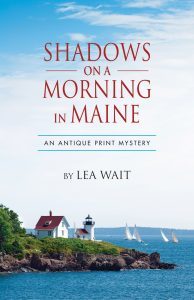
Of course, I’m sitting around or being bored. My next manuscript is due to my editor December 1. So, while I’ve been talking about this fall’s publications, I’ve been thinking a lot about plots, characters, clues, pacing … all the elements that, put together in the “right” order … become a mystery. Most specifically, I’m thinking about the book I’m writing.
My grandmother used to spread the pieces of a large jigsaw puzzle on the corner of our dining room table. (Except at holidays, when the table was actually used for dining. But that’s another story.) When I passed the table I was always tempted (as were other members of the family) to add one or more pieces. Matching colors were sorted. Edges were put together first. Corners were the easy parts. But seeing a picture in terms of shapes didn’t come easily to me. I enjoyed the puzzles, but I was not a master at jigsaw puzzle solving.
And now I write mysteries. Some authors are “seat of the pants writers” (“pantsers,” for short.) They sit at their computer keyboards and words flow, turning magically into characters and plots and solutions.
That’s not me. (I wrote one book that way, and it’s the only mystery I’ve written that has not sold. And it took three times as long to write as I normally allotted.)
I’m an “outliner.” Not the sort my fifth grade history teacher insisted on, with large As and small, Roman numerals and Arabic. But an outline of the plot and characters, nevertheless.
True, I leave some plot details to imagination (or serendipity,) to be developed while I write. But before I put my hands on that keyboard I know where I’m going to start, where I’m going to end, and have a fairly detailed idea of what will happen between those points.
When I speak at schools I often explain that writing is like putting together a giant jigsaw puzzle … a puzzle that begins with all white pieces, and no edges. The pieces are parts of the book: characters. Scenes. Weather. Time frames. Clues. A murder weapon (or two.) Suspects. Motivations.
Is it winter, or spring? Is my protagonist angry or contented, haunted by his or her past, or afraid of the future? Why does he or she get involved with solving the crime? Who will die? Why? How? Do they deserve it? What secrets do each of the main characters have? Do those secrets overlap? How do they complicate the plot?
Some puzzle pieces are the characters’ backstories. Their relationships with each other, then and now. Is there a romance? Is it in trouble? Is there a business that must be run while the crime is being solved? Are there children or elderly relatives who must be cared for? Friends with difficulties? Do any of the characters have flaws that complicate resolving the crime?
What about the unpredictable. Will there be a storm? A flood? An automobile accident? An unrelated crime that confuses both the police (yes, they’re in there, too) and the protagonist?
Could there be a second murder? Or even a third?
The answers to all of those questions become jigsaw puzzle pieces that, when best put together, tell a story.
Sometimes sub-plots or minor characters take over, and demand more than their share of the puzzle. Theses must be ruthlessly disconnected from the rest of the plot and tossed on the floor, perhaps for a dog to nibble or a cat to hide. They have no place in the completed puzzle.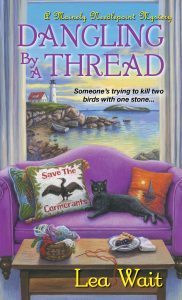
So now, as (I hope!) readers are sitting back and reading SHADOWS ON A MORNING IN MAINE, or anticipating and pre-ordering DANGLING BY A THREAD, I’m organizing the pieces of a Christmas mystery set in Haven Harbor, Maine which will be published in November of 2017. I know who dies. I’m pretty sure who the murderer is. I want to set my characters and plot in a realistic (but slightly glamorized) Maine holiday setting.
And, of course, there will be red herrings and Christmas ornaments and eggnog and cats and lots of motivations and secrets.
When the puzzle is complete, I hope the picture I’ve put together is a true one, and a Christmas my readers won’t forget — at least for about three hundred pages.
For right now … I’m putting together the pieces.

